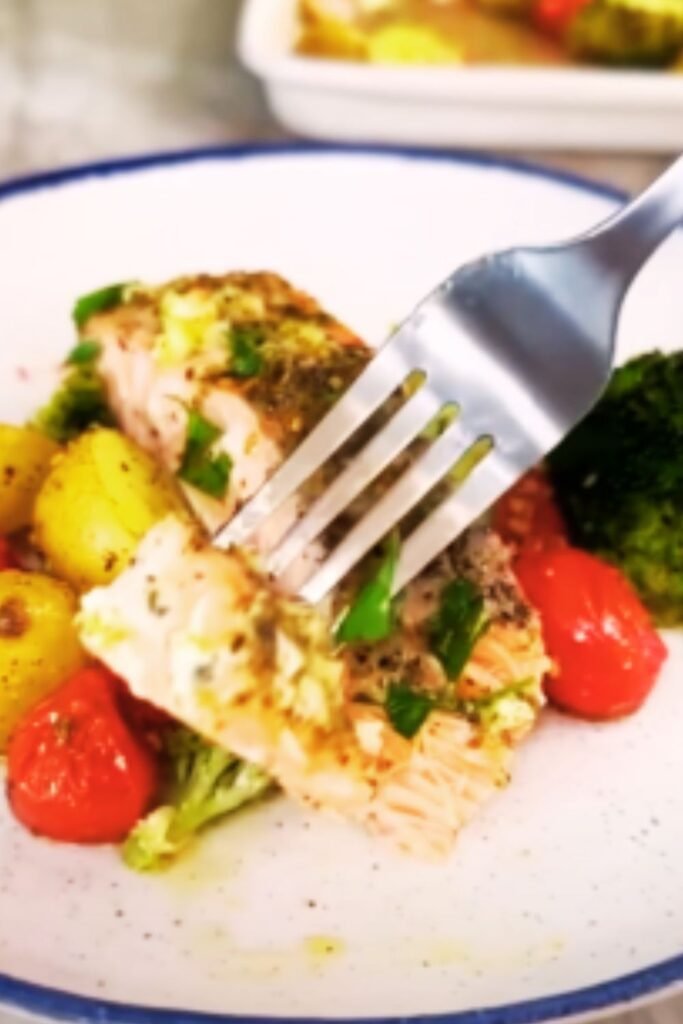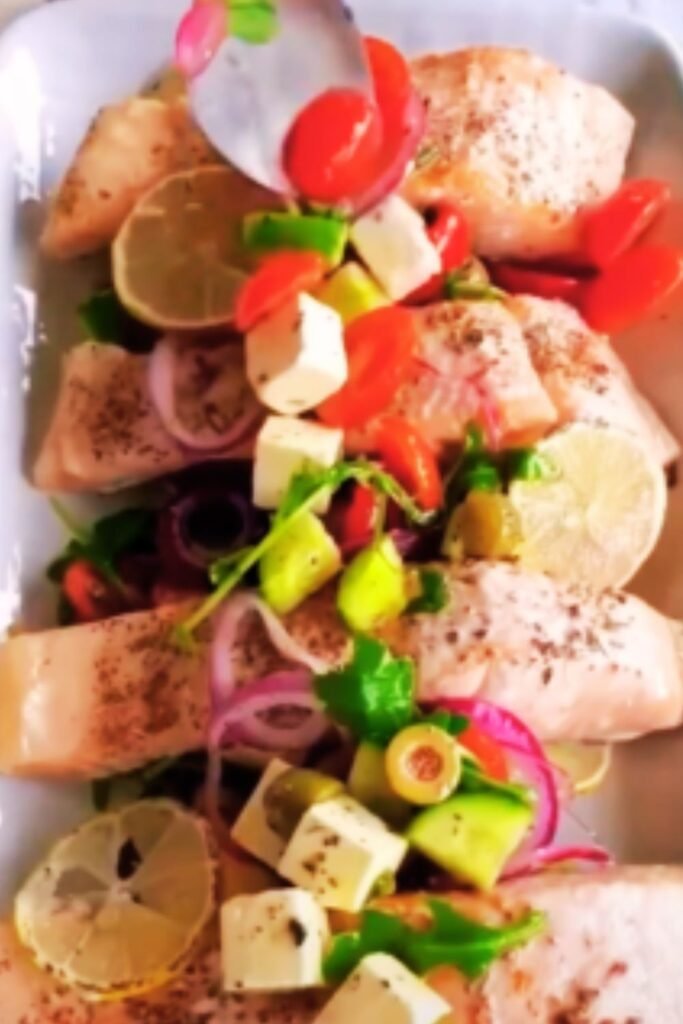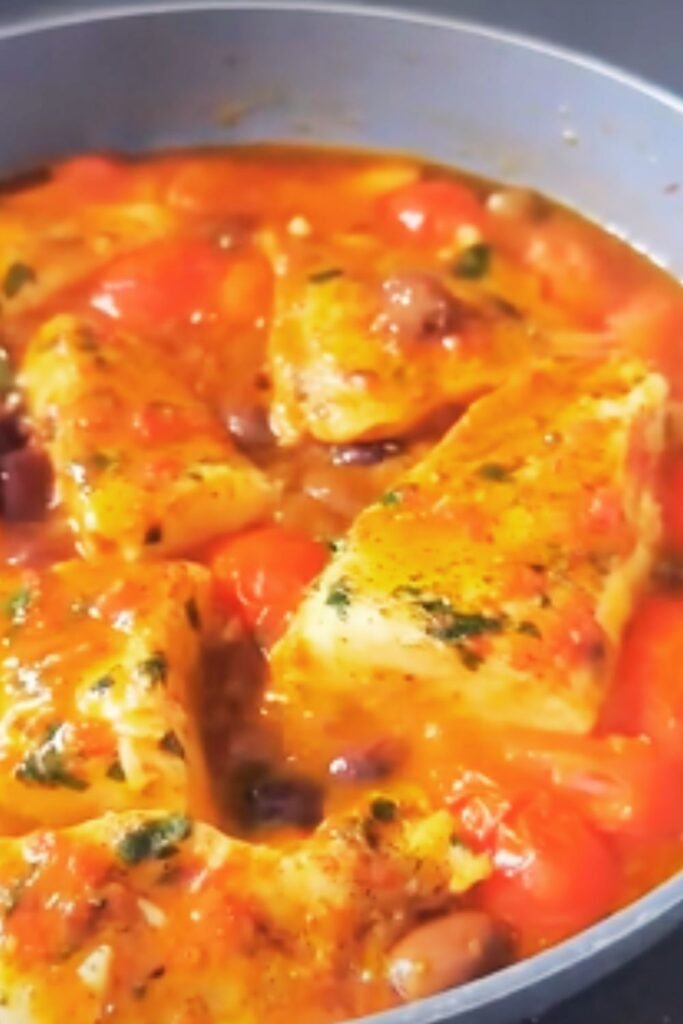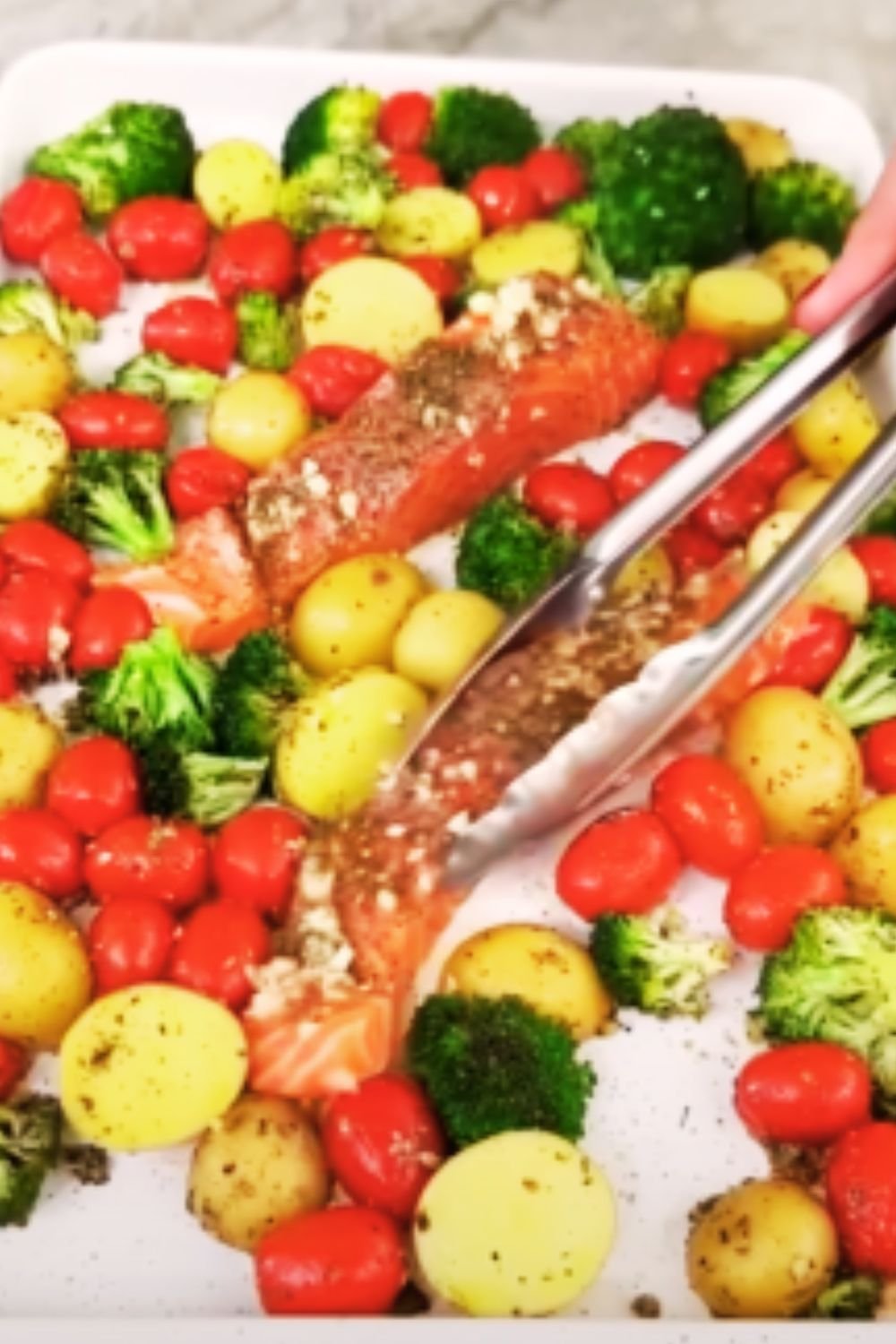There’s something magical about Mediterranean flavors. The bright lemon, aromatic herbs, briny olives, and sweet tomatoes create a symphony of taste that transports you straight to a seaside taverna. When I discovered how to combine these flavors with salmon in a quick, one-pan meal, it revolutionized my weeknight dinner routine.
If you’re looking for a dinner that’s impressive enough for guests but simple enough for busy evenings, this Mediterranean salmon is your answer. The entire meal comes together in just 30 minutes with minimal cleanup. Better yet, it’s packed with nutrients, protein, and those healthy omega-3 fatty acids we all need more of.
I’ve been making this dish for years, tweaking and perfecting it along the way. Today, I’m sharing my ultimate version – a colorful medley of salmon fillets nestled among roasted vegetables, all infused with classic Mediterranean seasonings.
Why You’ll Love This Recipe
This Mediterranean salmon isn’t just delicious – it’s practical in so many ways:
- One pan wonder: Everything cooks together on a single sheet pan
- Ready in 30 minutes: Perfect for busy weeknights when time is precious
- Nutritionally balanced: Lean protein, healthy fats, and plenty of vegetables
- Naturally gluten-free: No modifications needed
- Visually stunning: The colors and textures make for a beautiful presentation
- Meal prep friendly: Components can be prepped ahead and leftovers store well
- Customizable: Easily adapted based on your vegetable preferences or what’s in season
Ingredients

For 4 servings, you’ll need:
For the Salmon:
- 4 salmon fillets (6 oz each), skin-on preferred
- 2 tablespoons extra virgin olive oil
- 3 cloves garlic, minced
- 1 lemon (zest and juice)
- 1 tablespoon fresh oregano, chopped (or 1 teaspoon dried)
- 1 tablespoon fresh thyme leaves (or 1 teaspoon dried)
- 1 teaspoon dried dill
- Salt and freshly ground black pepper
For the Vegetables:
- 1 pint cherry tomatoes, halved
- 1 large red onion, cut into wedges
- 1 red bell pepper, chunked
- 1 yellow bell pepper, chunked
- 1 medium zucchini, sliced into half-moons
- ½ cup kalamata olives, pitted
- ¼ cup feta cheese, crumbled
- 2 tablespoons capers, drained
- 3 tablespoons olive oil
- 2 cloves garlic, minced
- 1 teaspoon dried oregano
- Salt and freshly ground black pepper
For Garnish:
- Fresh parsley, chopped
- Fresh dill sprigs
- Lemon wedges
Kitchen Equipment Needed
- Large rimmed baking sheet (half-sheet pan)
- Parchment paper or aluminum foil
- Small mixing bowl
- Measuring spoons
- Sharp knife and cutting board
- Citrus zester/microplane
Nutritional Information
| Nutrient | Amount per Serving |
|---|---|
| Calories | 425 |
| Protein | 35g |
| Carbohydrates | 12g |
| Fiber | 4g |
| Sugar | 6g |
| Fat | 26g |
| Saturated Fat | 5g |
| Omega-3 Fatty Acids | 1,800mg |
| Cholesterol | 94mg |
| Sodium | 580mg |
| Vitamin A | 45% DV |
| Vitamin C | 180% DV |
| Calcium | 15% DV |
| Iron | 10% DV |
Step-by-Step Instructions
Preparation
- Preheat your oven to 425°F (220°C). Line a large rimmed baking sheet with parchment paper or foil for easier cleanup.
- Remove salmon from refrigerator and let it sit at room temperature for 10-15 minutes while you prep the vegetables.
- Prepare all vegetables: halve cherry tomatoes, cut onion into wedges, chunk bell peppers, and slice zucchini.
Step 1: Season and Start Roasting the Vegetables
In a large bowl, combine all the prepared vegetables (except the feta) with olive oil, minced garlic, dried oregano, salt, and pepper. Toss until everything is well coated.
Spread the vegetable mixture evenly on the prepared baking sheet, making sure they’re in a single layer. If they’re too crowded, they’ll steam rather than roast.
Place the baking sheet in the preheated oven and roast the vegetables for 10 minutes.
Step 2: Prepare the Salmon
While the vegetables are getting a head start, prepare the salmon fillets. In a small bowl, combine the olive oil, minced garlic, lemon zest, lemon juice, oregano, thyme, dill, salt, and pepper.
Place the salmon fillets on a plate and pat them dry with paper towels. This helps the seasoning stick better and promotes better browning.
Brush the herb-oil mixture all over the salmon fillets, making sure to coat both sides.
Step 3: Add Salmon to the Pan
After the vegetables have roasted for 10 minutes, remove the baking sheet from the oven. Gently push the vegetables aside to create spaces for the salmon fillets.
Place the seasoned salmon fillets on the baking sheet, skin-side down, nestled among the vegetables.
Scatter the kalamata olives and capers around the salmon and vegetables.
Step 4: Finish Roasting
Return the baking sheet to the oven and continue roasting for 10-12 minutes, or until the salmon is just cooked through and flakes easily with a fork.
The exact cooking time will depend on the thickness of your fillets. For medium-rare salmon, cook until the internal temperature reaches 125°F (52°C). For medium, aim for 130°F (54°C).
Step 5: Add Finishing Touches
Once everything is cooked, remove the baking sheet from the oven. Sprinkle the crumbled feta cheese over the vegetables, allowing it to slightly melt from the residual heat.
Garnish with fresh chopped parsley, dill sprigs, and serve with lemon wedges for an extra burst of freshness.

Tips for Perfect Mediterranean Salmon
Choosing the Best Salmon
When shopping for salmon, I look for:
- Freshness: The fish should have a clean, oceanic smell – never fishy or ammonia-like
- Appearance: Look for moist, firm flesh with no brown spots or discoloration
- Source: Wild-caught salmon typically has better flavor and nutrition than farmed
- Sustainability: Check for certification from organizations like the Marine Stewardship Council
- Color: Wild salmon ranges from deep red to orange, depending on the species
My personal preference is for wild Alaskan sockeye or coho salmon, but use whatever variety is freshest and fits your budget.
Common Mistakes to Avoid
- Overcooking the salmon: Salmon continues cooking after you remove it from the heat, so take it out when it’s just shy of your desired doneness.
- Overcrowding the pan: Give vegetables enough space to roast rather than steam.
- Not drying the salmon: Patting the fillets dry before seasoning helps achieve better browning.
- Under-seasoning: Fish needs adequate salt to bring out its flavor.
- Using cold salmon straight from the fridge: Let it sit at room temperature for 10-15 minutes before cooking for more even results.
Make-Ahead Options
This dish works wonderfully for meal prep:
- Prep vegetables: Cut all vegetables up to 2 days ahead and store in airtight containers.
- Make herb mixture: Prepare the herb-oil mixture for the salmon up to 24 hours ahead.
- Partial cooking: You can roast the vegetables ahead of time and reheat them with the fresh salmon.
Variations and Substitutions
Different Protein Options
While salmon is the star here, this recipe works beautifully with other proteins:
- Other fish: Try sea bass, halibut, or cod (reduce cooking time for thinner fillets)
- Chicken: Use boneless, skinless chicken breasts (increase cooking time to 20-25 minutes)
- Shrimp: Add them during the last 5-6 minutes of cooking
- Plant-based: Replace salmon with thick slices of firm tofu or tempeh
Seasonal Vegetable Swaps
Depending on the season, mix up your vegetables:
- Spring: Asparagus, baby artichokes, spring onions
- Summer: Eggplant, summer squash, green beans
- Fall: Butternut squash, brussels sprouts, fennel
- Winter: Cauliflower, root vegetables, hearty greens
Dietary Adaptations
- Dairy-free: Omit the feta cheese or replace with a dairy-free alternative
- Lower carb: Add more non-starchy vegetables like cauliflower or broccoli
- Higher carb: Toss in some baby potatoes or serve over quinoa or farro
- AIP/Paleo: Skip the nightshades (tomatoes and bell peppers) and use olives and artichokes instead
Serving Suggestions

This Mediterranean salmon is a complete meal on its own, but here are some delicious accompaniments:
- Crusty whole grain bread for soaking up the flavorful juices
- A simple green salad with lemon vinaigrette
- Cooked quinoa or farro for extra whole grains
- Tzatziki sauce on the side for a cool contrast
- Greek yogurt mixed with herbs as a creamy topping
- Hummus or baba ganoush with crudités as a starter
- Sparkling water with cucumber and mint
Storage and Reheating
Leftover Mediterranean salmon can be stored in an airtight container in the refrigerator for up to 2 days. For best results:
- Reheating in the oven: Cover with foil and warm in a 275°F (135°C) oven for about 10 minutes to prevent drying out.
- Microwave method: Use 50% power and heat in 30-second intervals until just warmed through.
- Cold option: The leftovers are actually delicious cold or at room temperature as part of a salad or grain bowl.
I don’t recommend freezing this dish as the vegetables will become mushy and the salmon texture suffers when thawed.
Health Benefits
This Mediterranean-inspired dish isn’t just delicious – it’s nutritional powerhouse:
Salmon Benefits:
- Rich source of omega-3 fatty acids that support heart and brain health
- High-quality complete protein for muscle maintenance and repair
- Contains astaxanthin, a powerful antioxidant
- Provides vitamin D, often lacking in many diets
- Excellent source of B vitamins, especially B12
Vegetable Benefits:
- Bell peppers provide more vitamin C than oranges
- Tomatoes offer lycopene, linked to reduced cancer risk
- Olives contain heart-healthy monounsaturated fats
- Garlic has natural antibacterial and anti-inflammatory properties
- Overall vegetable variety provides fiber, vitamins, minerals, and phytonutrients
Frequently Asked Questions
Q: Can I use frozen salmon for this recipe?
A: Yes, but thaw it completely first and pat it very dry to remove excess moisture. You may need to add a minute or two to the cooking time.
Q: How can I tell when salmon is perfectly cooked?
A: Perfectly cooked salmon will flake easily with a fork but still maintain some translucence in the center. If you have an instant-read thermometer, aim for 125°F (52°C) for medium-rare or 130°F (54°C) for medium.
Q: What’s the best way to remove salmon skin?
A: I recommend cooking salmon with the skin on as it helps keep the fish moist. You can easily separate the cooked fish from the skin when serving. If you prefer removing it before cooking, use a sharp knife to slide between the skin and flesh.
Q: Can I make this dish for a crowd?
A: Absolutely! Simply double or triple the recipe and use multiple sheet pans. Make sure not to overcrowd the pans, or the vegetables won’t roast properly.
Q: My family doesn’t like olives. What can I substitute?
A: You can omit them entirely or replace with artichoke hearts, sun-dried tomatoes, or even some pine nuts added during the last few minutes of cooking.
Q: Is this recipe suitable for meal prep?
A: While best enjoyed fresh, you can prepare components ahead of time. For meal prep containers, I recommend slightly undercooking the salmon, then reheating gently to prevent overcooking.
Q: How spicy is this dish?
A: This Mediterranean salmon isn’t spicy at all, but you can add red pepper flakes if you’d like some heat.
Q: What can I do with leftover roasted vegetables?
A: Leftover vegetables are delicious tossed with pasta, added to omelets, or blended into a creamy soup.
Why This Recipe Works
The success of this one-pan Mediterranean salmon comes down to a few key principles:
- Two-stage cooking: By giving the vegetables a head start, everything finishes perfectly at the same time.
- High heat: The 425°F oven creates beautiful caramelization on both the vegetables and salmon.
- Complementary flavors: The sweet vegetables, briny olives, fresh herbs, and rich salmon create a balanced profile.
- Proper spacing: Creating room for the salmon among the vegetables allows everything to roast rather than steam.
- Fat balance: The natural oils in salmon plus olive oil ensure nothing dries out.
I’ve been perfecting this recipe for years, and these simple techniques consistently deliver restaurant-quality results. The Mediterranean flavor profile works so beautifully with salmon that it’s become one of my signature dishes for both family dinners and entertaining.
Whether you’re new to cooking fish or a seasoned chef, this foolproof method delivers spectacular results every time. The vibrant colors, magnificent aromas, and incredible taste will have everyone asking for seconds—and for your recipe!
Give this Mediterranean salmon a try tonight, and I’m confident it will earn a spot in your regular dinner rotation. It’s the perfect balance of healthy, delicious, and effortless—exactly what modern cooking should be.


